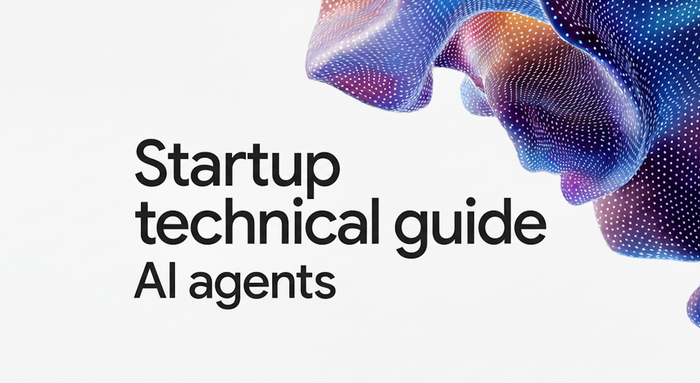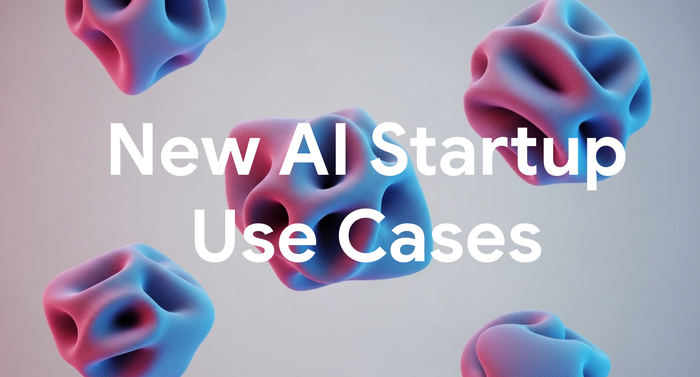Moneyball for the Front Office
Google Cloud Content & Editorial
Try Google Cloud
Start building on Google Cloud with $300 in free credits and 20+ always free products.
Free trialIn 2002, the Oakland Athletics’ successful application of sabermetrics – which was later popularized by the film Moneyball – transformed professional baseball (and later, most other sports) by applying statistics and data science to win games. For years, sports analytics efforts were focused on player stats and game outcomes. Today, the same applied statistics have come to the front office to drive ticket sales, merchandise sales, corporate packages, and new forms of fan engagement.
Sports teams from all over the world suffered when COVID shortened seasons and emptied stadiums in 2020. This lack of in-person events has been intensified by increasing advertising costs and shifts in Millenial and Gen-Z engagement channels. Teams are looking to bounce back by using customer data to engage fans across channels via personalized campaigns.
But, where to start? Brian Shield, SVP and CTO of The Boston Red Sox, saw an opportunity to supercharge his analytics team to build a robust fan acquisition and engagement capability for the business.
Investing in Cloud Analytics
Initially, Shield considered using a customer data platform (CDP), but given he’d already invested in BigQuery as the company’s cloud data warehouse, creating a separate data silo didn’t make sense. Plus, the high engineering effort required to set up a customer data platform to launch campaigns meant the time-to-value was too slow. Shield needed a way to leverage his data in BigQuery to power high-performing marketing and sales campaigns as quickly as possible.
“Regarding CDPs, we want to control our own destiny, we want a platform that will scale with us. A CDP can be a useful tool but is not a substitution for an owned First-Party Modern Data Stack on Google Cloud. I think people are making a mistake putting all their eggs in that basket. How do you ever migrate in the future if you want to move away from a 3rd-party vendor? It’s like starting over to extract yourself. By owning the architecture, you avoid vendor lock-in. That’s what we love about the architecture we’ve built with GrowthLoop,” Shield said.
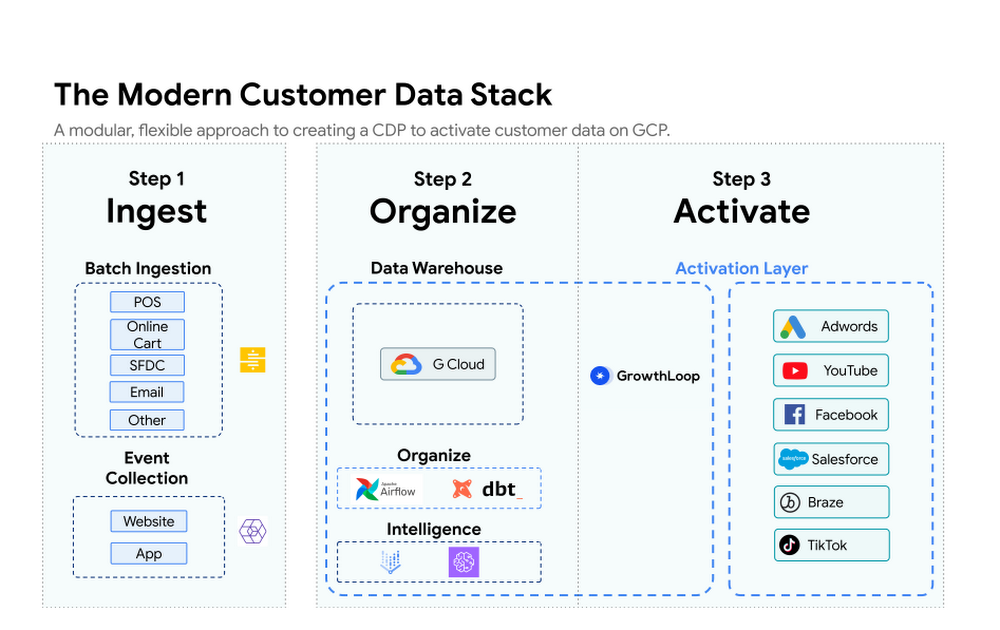

BigQuery and GrowthLoop Software Deliver Growth Faster
GrowthLoop, formerly Flywheel Software, offered an innovative, new architecture capable of enriching BigQuery data sets with ticketing data, merchandise sales data, fan engagement and other important business data sources. By connecting sales and marketing teams directly to Red Sox customer data in BigQuery, GrowthLoop enabled the Red Sox team to leverage its B2B and B2C data immediately , without being limited by slow ETL pipelines and inflexible data models.
For the first time, the Red Sox marketing team could create audience segments with GrowthLoop’s no-code builder, and launch campaigns within hours instead of weeks. Freed from constant SQL queries and audience list pulls, the data team could focus on building more sophisticated predictive models.
“We went from spending all of our time answering data requests to a self-service model with scalable data democratization via GrowthLoop, which allows our team to be more proactive vs reactive,” said Jon Hay, Vice President Data, Intelligence & Analytics, Boston Red Sox.
How GrowthLoop and BigQuery Work Together
Customer 360: GrowthLoop helped the Red Sox combine all of their data sources into a single view of their customers in BigQuery, then connected them to every marketing and sales channel via GrowthLoop’s platform.
Predictive Models: The Sales team deployed a fan avidity score predictive model trained on BigQuery data to more efficiently target outreach.
BigQuery Access and Data Sharing: Red Sox data can be seamlessly combined with Major League Baseball data using BigQuery’s data-sharing capabilities.
Extensible Data Visualization: Since GrowthLoop writes all audience data back to BigQuery, the Red Sox analytics team can perform its own performance analysis.
“As Fenway Sports Group continues to evolve, we see our data prowess and the extensible architecture we’ve built with GrowthLoop as an asset that new FSG Media & Entertainment properties can tap into to support their growth and evolution,” Shield said.
GrowthLoop Audience Segmentation
With GrowthLoop, analytics and activation live in one place, making audience design a five-minute exercise. This means the marketing team has more at-bats to find winning combinations of target audience, channel, and message.
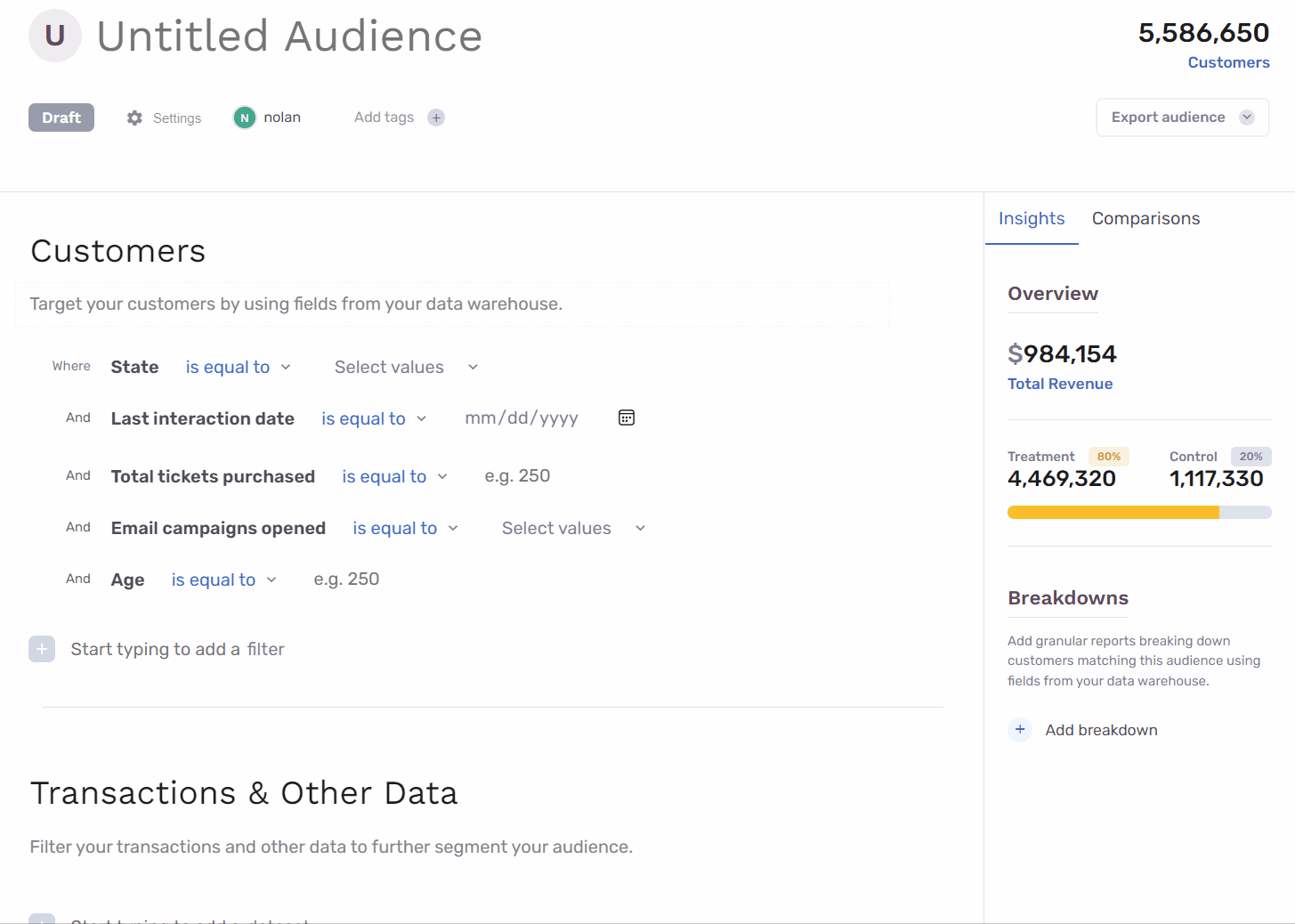

Uplift Measurement, the New Moneyball
With each audience launch, the Red Sox marketing team automatically applies ongoing A/B experiments by segmenting audience members into treatment and control groups in-app.
This experimental design unlocks visualizations for marketers to quickly understand the impact on ticket sales, ticket scans, total spend, number of games watched via streaming services, email opens, Salesforce opportunities closed, app logins, or any other metric in BigQuery.
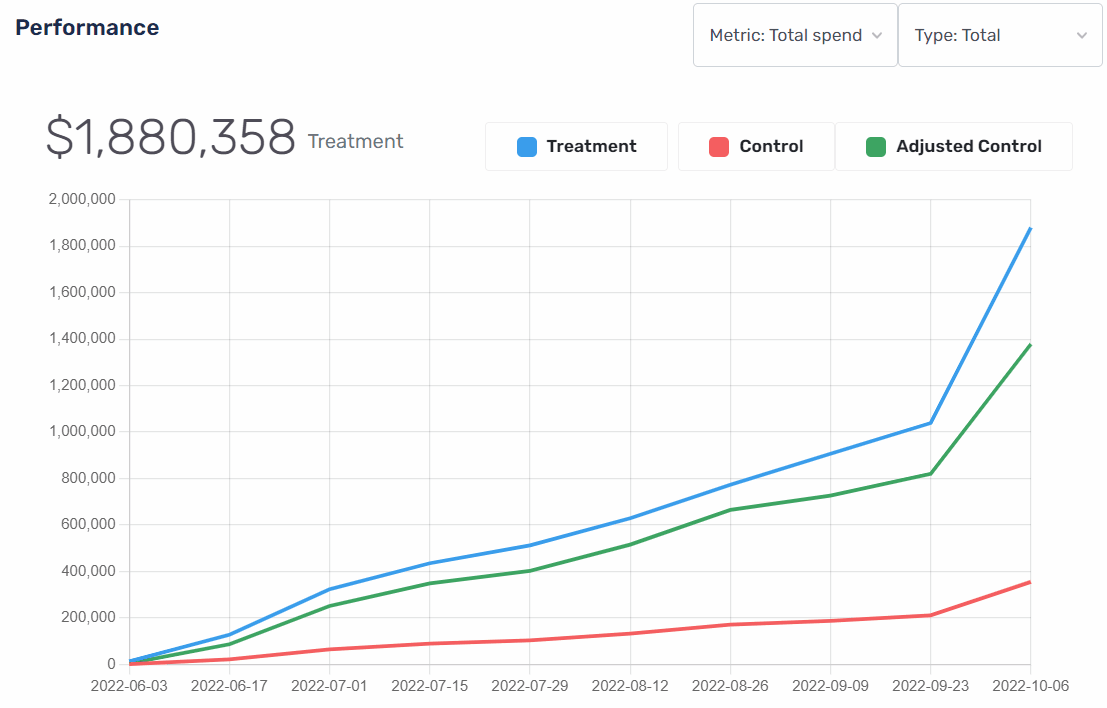

The Boston Red Sox Reference Architecture
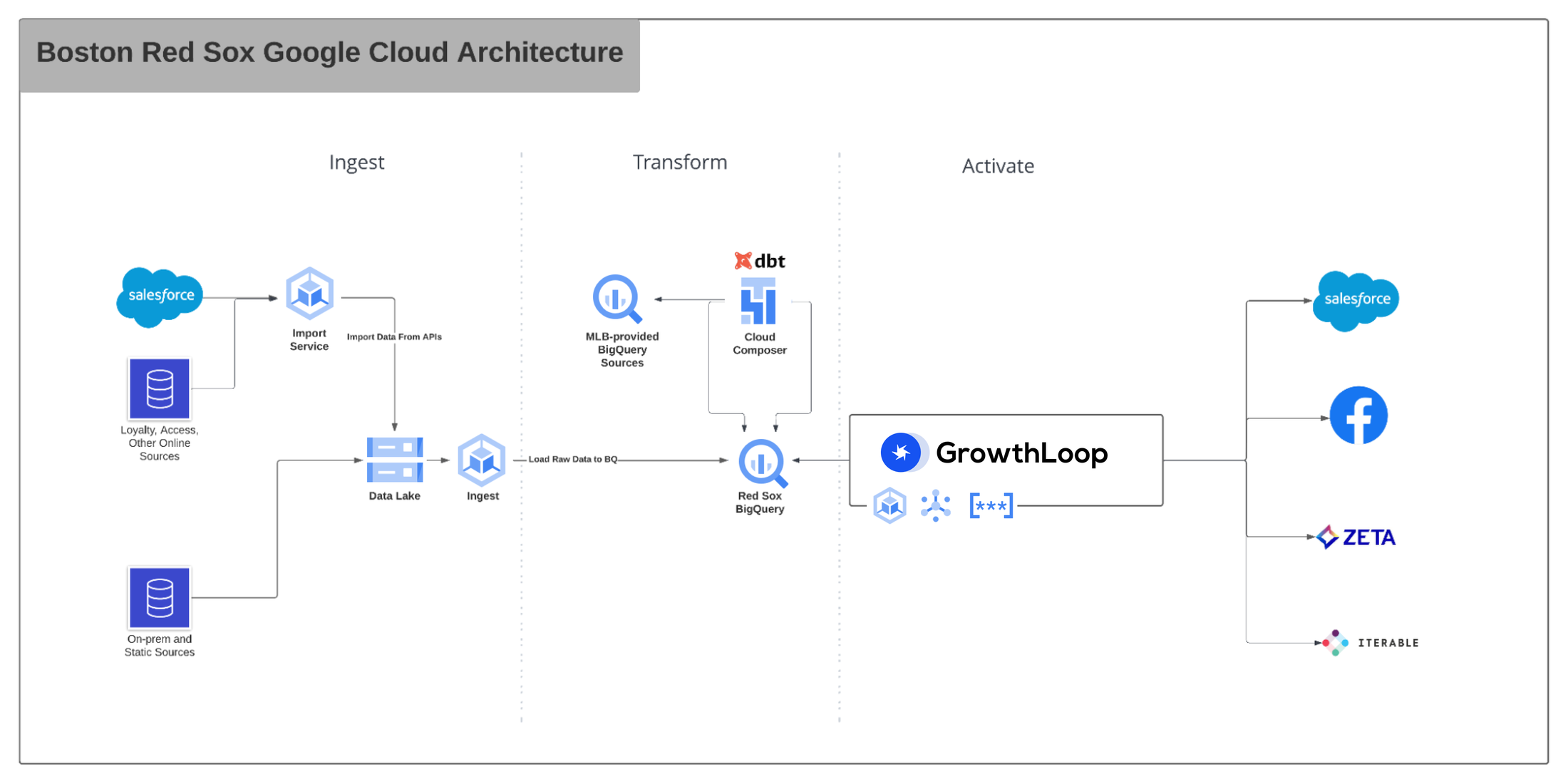

Brian Shield leveraged several Google Cloud services to ingest, transform and activate Red Sox data:
Ingest data sources via an Import Service running in Google Kubernetes Engine (GKE) and Cloud Storage, though you can use self-serve ETL tools like Matillion;
Transform data with data build tool (dbt) via Cloud Composer to produce transparent and reliable data pipeline models.
Activate data with GrowthLoop, deployed on Google Cloud and using GKE, Pub/Sub and other services to deliver audiences and personalization fields to Salesforce, Facebook, Zeta, and Iterable. (GrowthLoop supports any destination with extensive API integrations.)
“GrowthLoop enabled and then dramatically accelerated the Red Sox transition to a data-driven organization,” said Hay.
Winning Segments
So what kind of marketing segments were successful for the Red Sox that your team could apply? Here is a quick summary of a few key examples:
Take Advantage of Timely Buyer Patterns
Encouraging the away team’s fans to attend a game at their home stadium may seem counterproductive, but it turns out to be a great revenue opportunity. For example, target the Oakland A’s fans that live in the Boston area (via Google Ads or email) to purchase tickets when the Red Sox play the Oakland A’s.
Deeper Segmentation and Hyper-Personalization
Build an audience with deeper segmentation based on data points in your BigQuery tables to achieve higher conversion rates. One of the highest-leverage customer segments is single-game ticket buyers with a high propensity to buy season tickets. The Red Sox have an AI model that scores fans on this propensity. When a high-scoring fan purchases a ticket to a homestand game, a sales rep is immediately notified via Salesforce to call the fan and set up a VIP tour before the game, giving the rep an opportunity to upsell season ticket packages.
Deliver High Quality Leads for your Sales Team
Leverage data in BigQuery to set your sales team up for success with campaigns targeting the right buyers at the right time. One example is sending existing purchasers of suites that don’t yet have a concessions package and have visited the website recently to the CRM as warm leads for the sales team.
“Our sales team refers to the Audience Builder as the GrowthLoop Lead machine” - Jon Hay, Vice President Data, Intelligence & Analytics, Boston Red Sox
Transform Your “Front Office” like the Boston Red Sox in 3 Easy Steps
Today, eight other Major League Baseball teams leverage GrowthLoop to drive marketing and sales wins, along with teams across the NBA, NHL, and NASCAR. Whether your company is in retail, financial services, travel, software, or something else entirely, you can join the expanding group of companies driving sustainable growth through real-time analytics by connecting BigQuery from Google Cloud to GrowthLoop. Here’s how:
If you have Customer Data in BigQuery…
Book a GrowthLoop + BigQuery demo customized to your use cases.
Link your BigQuery tables and marketing and sales destinations to the GrowthLoop platform.
Launch your first GrowthLoop audience in less than one week.
If you are getting started with BigQuery…
Get a Data Strategy Session with a GrowthLoop Solutions Architect at no cost.
Use our Quick Start Program to get started with BigQuery in 4 to 8 weeks.
Launch your first GrowthLoop audience in less than one week thereafter.
The Built with BigQuery advantage for ISVs and Data Providers
Google is helping companies like GrowthLoop build innovative applications on Google’s data cloud with simplified access to technology, helpful and dedicated engineering support, and joint go-to-market programs through the Built with BigQuery initiative. Participating companies can:
Accelerate product design and architecture through access to designated experts who can provide insight into key use cases, architectural patterns, and best practices.
Amplify success with joint marketing programs to drive awareness, generate demand, and increase adoption.
BigQuery gives ISVs the advantage of a powerful, highly scalable data warehouse that’s integrated with Google Cloud’s open, secure, sustainable platform. And with a huge partner ecosystem and support for multi-cloud, open source tools and APIs, Google provides technology companies the portability and extensibility they need to avoid data lock-in.
Click here to learn more about Built with BigQuery.

